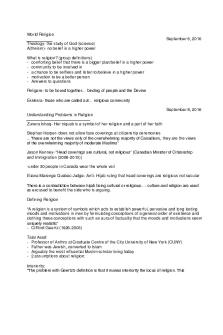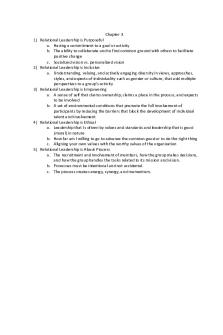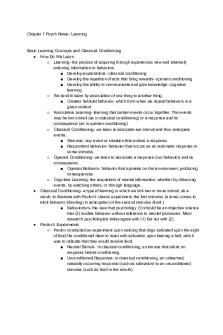Exploring Strategy Summary Chapter 1-3 PDF

| Title | Exploring Strategy Summary Chapter 1-3 |
|---|---|
| Course | International Corporate Strategy |
| Institution | Hochschule Fresenius |
| Pages | 11 |
| File Size | 326 KB |
| File Type | |
| Total Downloads | 112 |
| Total Views | 151 |
Summary
Download Exploring Strategy Summary Chapter 1-3 PDF
Description
Strategic Managem Management ent Strategy What is strategy? -
“The long-term direction of an organization”. “The determination of the long-run goals and objectives of an enterprise and the adaptation of course of action and the allocation of resource necessary for carrying out these goals”. - “Competitive strategy is about being different. It means deliberately choosing a different set of activities to deliver a unique mix of value”. - “A pattern in a stream of decisions”. - “The long-term direction of an organization”. Because strategy involves managing people, relationships and resources it is called “strategic management”.
What is strategic management? The direction and scope of organizations over long term, which achieves advantage in changing environment through configuration of resources/competences with aim to fulfill stakeholder expectations. It includes understanding strategic position organization, making strategic choices for future and managing strategy in action.
Levels of strategy 1. -
Corporate-level strategy concerned with overall scope of organization and how value is added to constituent businesses of organizational whole. Examples: geographical scope, diversity of products/services, acquisition of new businesses and allocation of resources between different elements of organization. Important → Basis for other strategic decisions like acquisition/alliances.
2. Business-level strategy - Concerned about how individual businesses should compete in their markets (competitive strategy). - Standalone businesses (entrepreneurial start-ups) or business units (within larger corporation). - Typically concerned with innovation, appropriate scale/response to competitors’ moves. - When business units are within larger organizations → business-level strategy should fit with corporate-level strategy.
3. Operational strategies - Concerned with how components of organization deliver effectively corporate- and business-level strategies in terms of resources, processes and people. - Most successful business strategies depend largely on decisions/activities made on operational level. - Operational decisions need to be closely linked to business-level strategy → Vital for success.
Vocabulary in Strategy -
-
-
-
-
Mission Mission: o Relates to goals and overall purpose of organization o “What business are we?” o Keeps focus on central aspects of strategy Vision: o Related to goals and desired future states o Aspiration/motivation for members o “What do we want to achieve?” Objectives: o Precise and quantifiable goals over period of time o Refer to market share targets or examination results in school o “What do we want to achieve?” Scope: o Refers to three dimensions (customers, geographical location and extent of internal activities = vertical integration) Advantage: o Part of strategy o Describes how to achieve objectives o Refers to competitive advantage o How to achieve goals in face of competition
The Exploring Strategy Model -
-
Includes understanding of o Strategic position of organization o Assessing strategic choices for future o Managing strategy in action “The Exploring Strategy Model provides a comprehensive and integrated framework for analyzing an organization’s position, considering the choices it has and putting strategies into action”.
Example: -
-
Job-seeker needs to understand job market first, then evaluate their strengths and weaknesses, establish range of job opportunities and decide what career goals are (positioning issues). Job-seeker narrows down options, makes applications and gets an offer (choice issues). Once job is chosen, job-seeker sets to work, adjusting skills and behaviours to fit new role (strategy in action). Non-linear, overlapping Exploring Strategy Model → putting career strategy into action → better understanding of strengths and weaknesses → setting new goals.
1. Strategic Position Is concerned with the impact on strategy of external environment, organisation’s strategic capability and expectations and influence of stakeholders. -
-
-
-
-
Is concerned with o Impact on strategy of external environment o Organisation’s strategic capability (resources/competences) o Expectations and influence of stakeholders Environment: o Organisations operate in complex political, economic, social and technological world. o Environment is dynamic and changes o Focus on opportunities and threats Strategic capability: o Each organization has their own capabilities (resources/competences) o Focus on organisation’s strengths and weaknesses o “Where is it at a competitive advantage?” o “Are organisation’s capabilities adequate for challenges of environment and for reaching their goals?” Strategic purpose purpose:: o Purpose encapsulated in organisation’s vision, mission and objectives o Mostly unclear, contested or unrealistic o “What is organisation’s strategic purpose; what does it seek to achieve?” o Issue of corporate governance → how to ensure managers stick to agreed purpose o Questions of purpose and accountability raise issues of corporate social responsibility and ethics → “Is purpose appropriate and are managers sticking to it?” Culture: o Can influence strategy o Typically, product of organisation’s history o Culture and history can lead to strategic drift → failure to create necessary changes o “How does culture fit with required strategy?”
Layers of Business Env Environment ironment -
-
-
Creates opportunities and threats Important try to analyze environments carefully to anticipate or influence environmental change Macro-environment: o Impact to greater/lesser extent almost all organizations o PESTEL to identify key drivers of change to construct scenarios Industry or sector: o Made up of organizations producing same products/services. o Porter’s 5 forces for understanding attractiveness of sectors and threats from outside the present competitors. Competitors and mark markets: ets: o Most immediate layer surrounding organizations
o o o
Strategic groups can help identify different kinds of competitors Market segments can be used to understand customer’s expectations Strategy canvas can be used to analyze competitors’ relative positions and to indetify Blue Ocean opportunities.
1. Macro-Environment (PESTEL) Is used to analyze poli political, tical, economic, so social-cultural, cial-cultural, technological, envir environment onment and llegal egal changes in business envir environment. onment. -
Used for analyzing macro-environment Provides overview and builds scenarios Helps to understand “big picture” of changes of force And take advantage of opportunities
Example: -
-
Opportunities can com come e from: o new technologies o from new funding streams o from changes government policies. Threats can include: o deregulation → explosion to intensified competition o shrinking markets o increased interest rates → problematic if burdened by debt
PESTEL Analysis Factors Political factors -
government/regional regulations Election Property rights Corruption/organized crime Legislation Business regulation
Economic Factors -
Stability of economy Exchange rates Income Unemployment rate Globalization Porter Porter’s ’s 5 Forces
-
Technological F Factors actors -
-
Demographics Attitudes Health, education, social mobility Restriction on mergers and acquisitions Taxation
Innovative technology Government/institutional regulations Infrastructure …
Environmental -
Social-Cultural Fact Factors ors
Employment/job trends Religious beliefs Change in lifestyle … Hofstede’s Cultural D Dimensions imensions
Pollution Environmental regulations New opportunities/threats (green market) …
Legal -
Legislative and regulatory constraints or changes?
Main Focus -
-
-
Megatrends o Can be social, economic, political, ecological or technological changes o Example 1: Megatrend ageing population affects social care, retail spending and housing. o Example 2: Megatrend rapid economic growth in Asia drives employment patterns in advanced economies and commodity prices worldwide. Inflexion Inflexion: o Moments when trends shift direction, like increasing/decreasing o Example: Retailing has declined due to internet shopping. o Take advantage or take actions against escalating decline Weak signals: o Advanced signs of future trends o Example 1: Weak signals for financial crisis in 2008 was the rise in mortgage failures in California the previous year.
o Example 2: Weak signal for current success of Asian business schools was the first entry of Hong Kong University of Science and Technology into “Financial Times” ranking of the top 50 international business schools in early 2000s. o Stream of isolated and random bits of information without strategic importance, like o Repetition of signal, vehement disagreement among experts about signal’s significance and unexpected failure in something that previously had worked.
Scenario Analysis -
Allow for different possibilities → help managers prevent from closing minds to alternatives Plausible views how business environment might develop Typically build on PESTEL and key drivers for change o Defining scenario scop scope e (time span, industry, geographical location, markets) o Identifying key drivers (major impact on future of industry, e.g. demographics, technology, uncertainty, mutual independence) o Developing scenari scenario o (develop plausible stories) o Identifying impacts of alternatives on o organization rganization (opportunities, threats) o Establishing early warning systems (identify early warning signs)
2. Industry (and sector) -
Competition within industry, sector or market Industry → same products/services Market → group of customers Industry analysis → Porter’s five forces framework
Types of industry -
Five forces analysis helps identify main types of industry structure Identify broad categories → compare attractiveness of industry and broad patterns of competitive behavior. The four types are: o Monopolistic industri industries es ▪ monopoly → one firm, no competition ▪ Great power of buyers and suppliers ▪ Can be very profitable ▪ Examples: Microsoft, Facebook, water utility companies, Google. o Oligopolistic indu industries stries ▪ Just a few firms within industry ▪ Potential for limited rivalry ▪ Great power over buyers and suppliers ▪ Two firms (duopoly, example: Airbus and Boeing)
Can be highly profitable, but depends on rivalrous behavior, threat of entry, substitutes and market growth. ▪ Example: Steel industry o Hypercompetitive indu industries stries ▪ Frequency, boldness and aggression of competition creates constant disequilibrium and change. ▪ Competition invests heavily in destabilizing innovation, expensive marketing initiatives and aggressive price cuts. ▪ Industry is very dynamic ▪ Example: Mobile phone industry o Perfectly competitive indu industries stries ▪ Barriers to entry are low ▪ Many rivals with similar products/services and information about competitors is freely available. ▪ Example: Minicab services come close to perfect condition ▪ Some markets are perfectly competitive, but many are highly competitive ▪ Highly competitive markets: • firms are unable to earn more profit than bare minimum required to survive. • Main focus on price ▪ Good profits will be very hard to earn. Converging industries industries:: o Overlapping of industries through technological change etc. (e.g. phone and photo industry). ▪
-
3. Competitive forces – the Five Forces Framework -
-
Helps identify the attractiveness of an industry in terms of five competitive forces: o Threat of entry o Threat of substitutes o Power of buyers o Power of suppliers o Extent of rivalry between competitors Attractiveness → good profit potential (low competition and little threats)
Analysis should prompt investigation of implications of five forces: -
Which industry to enter? What influence can be exerted? (build entry barriers etc.) How are competitors differently affected? (not all will be affected by changes)
Threat of Entry -
Attractive industry → high barriers to entry → reduce threat of new competition Five important entry barriers are: o Economies of scale (high investment requirements) and experience (competitive advantage through learning). o Access to supply or distribution channels (manufacturers have control over supply and distribution channels). o Expected retaliation (entry too costly) o Legislation or government action (legal restraints, patent protection, regulation of markets, tariffs) o Differentiations (competitor offers higher perceived products or services)
Threat of Substitutes -
Price/performance ratio (pricing and value) Extra-industry effects (force to look outside own industry)
Power of Buyers -
Immediate, not ultimate consumers Powerful, they can demand cheap prices or products/service improvements Buyer power is high when: o Concentrated buyers (a few large customers account for majority of sales) o Low switching costs (buyers can switch easily suppliers) o Buyer competition threat (buyer has capability to supply itself, or to acquire capability)
Power of Suppliers -
Supply organization with product or service Power is high when: o Concentrated suppliers (a few suppliers dominate supply) o High switching costs (expensive or disruptive to switch suppliers) o Supplier competition threat (suppliers can cut out buyers)
Complementor/ Competit Competitor or -
Complementor enhances business attractiveness to customers/suppliers (e.g. McAfee and Microsoft). Instead of battling against each other for industry value, complementors cooperate to increase total value available. Keeping each other in touch with technological development → increases value of both their products. Opportunities for cooperation are seen through value net → organization with opportunities for cooperation and competition.
2. Strategic Choices Involve understanding underlying bases for future strategy at business unit and corporate level as well as options for developing strategy in terms of directions and methods of development. -
-
Involves options for direction and methods for strategy Business strategy: o Strategic choices organization uses to compete at business level (e.g. choose to be lowest cost competitor or highest quality) o “How should business unit compete?” Corporate strategy: o Concerned with issues of corporate scope o Which businesses to include in portfolio o Relates to appropriate degree of diversification (products offered and markets served)
Concerned with internal relationship between business units and corporate head office. Internal strategy: o Internationalization is form of diversification, but into new geographical markets. o “Where internationally should the organization compete?” Innovation and entrepr entrepreneurship: eneurship: o Innovation necessary to survive on market o Entrepreneurship craters new enterprises → innovation. o “Is organization innovating appropriately?” Acquisitions and allianc alliances: es: o Choices made about methods for pursuing strategies o They can build new businesses with own resources or o By acquiring other businesses or forming alliances o “Should organization buy another company, ally or to do it alone?” o
-
-
-
Strategic business uni unitt (SBU)? Is part of organization for which there is distinct external market for goods or services that is different from another SBU.
3. Strategy in action Is concerned with ensuring that strategies are working in practice. -
About how strategies are formed and implemented. Emphasis on practicalities of managing. Strategy performanc performance e and evaluation: o Managers decide whether existing and forecast performance is satisfactory o They choose between options to improve it.
-
-
-
-
o “Are the options suitable to match opportunities and threats?” o “Are they acceptable in eyes of stakeholders?” o “Are they feasible given capabilities available?” Strategy development processes: o Often developed through formal planning process. o Sometimes strategies are emergent → accumulated patterns of ad hoc decisions, bottom-up initiatives and rapid response to the unanticipated. o “What kind of strategy process should organization have?” o “Plan in detail or leave plenty of opportunities for emergence?” Organizing: o Once strategy developed, organization need to organize for successful implementation. o Each strategy → own specific configuration of structures and systems. o “What kinds of structures and systems are required for chosen strategy?” Leadership and strat strategic egic change: o Dynamic world → change inevitable o Managing change involves leadership at all levels o Not just one way of leading o But different styles and different levers for change o “How should organization manage necessary changes entailed by strategy?” Strategy practice: o Inside process of strategy development and change is hard, detailed work. o “Who should do what in the strategy process?” o “What people to include?” o “What activities and what methodologies can help them do it?”...
Similar Free PDFs

EXPLORING STRATEGY ELEVENTH EDITION
- 829 Pages

Airbnb Case - Exploring Strategy
- 2 Pages

Chapter 13 - Summary
- 4 Pages

Exploring World Religions Summary
- 19 Pages

Chapter 13 - Summary World Art
- 3 Pages

Chapter+13 - chapter 13
- 50 Pages

FULL Summary Strategy
- 84 Pages
Popular Institutions
- Tinajero National High School - Annex
- Politeknik Caltex Riau
- Yokohama City University
- SGT University
- University of Al-Qadisiyah
- Divine Word College of Vigan
- Techniek College Rotterdam
- Universidade de Santiago
- Universiti Teknologi MARA Cawangan Johor Kampus Pasir Gudang
- Poltekkes Kemenkes Yogyakarta
- Baguio City National High School
- Colegio san marcos
- preparatoria uno
- Centro de Bachillerato Tecnológico Industrial y de Servicios No. 107
- Dalian Maritime University
- Quang Trung Secondary School
- Colegio Tecnológico en Informática
- Corporación Regional de Educación Superior
- Grupo CEDVA
- Dar Al Uloom University
- Centro de Estudios Preuniversitarios de la Universidad Nacional de Ingeniería
- 上智大学
- Aakash International School, Nuna Majara
- San Felipe Neri Catholic School
- Kang Chiao International School - New Taipei City
- Misamis Occidental National High School
- Institución Educativa Escuela Normal Juan Ladrilleros
- Kolehiyo ng Pantukan
- Batanes State College
- Instituto Continental
- Sekolah Menengah Kejuruan Kesehatan Kaltara (Tarakan)
- Colegio de La Inmaculada Concepcion - Cebu







![[ Summary] Perilaku Konsumen (Chapter 13)](https://pdfedu.com/img/crop/172x258/lwz48glkp520.jpg)
